The Role of an RBT in ABA Therapy
The role of a Registered Behavior Technician (RBT) is essential in the field of Applied Behavior Analysis (ABA) therapy. These professionals work directly with clients affected by Autism Spectrum Disorder and other developmental issues to implement behavior plans designed by Board Certified Behavior Analysts (BCBAs).
What is an RBT?
An RBT is a paraprofessional certified by the Behavior Analyst Certification Board (BACB). They are trained to provide therapeutic interventions based on the principles of ABA under the supervision of a BCBA or a Board Certified Assistant Behavior Analyst (BCBA). The primary responsibility of an RBT is to directly implement behavior-analytic services, record and collect data on patient progress, and maintain a high standard of practice following the ethical guidelines set by the BACB.
To become an RBT, an individual must undergo a specific training process, pass a competency assessment, and successfully complete the RBT exam. Further details on the requirements and training process can be found on our RBT training page.
How RBTs Impact ABA Therapy
RBTs are instrumental in delivering consistent and effective ABA therapy. They are often the ones who spend the most time with clients, which allows them to build strong, trusting relationships that can facilitate progress in therapy. With their specialized training, RBTs are skilled in identifying and recording behavioral patterns, implementing intervention plans, and adapting to the unique needs of each client.
The impact of an RBT on ABA therapy can be seen in the improvements in clients' communication skills, social abilities, and overall behavior. Moreover, RBTs provide invaluable support to BCBAs by collecting accurate data, which is crucial for evaluating the effectiveness of treatment plans and making necessary adjustments.
The table below provides information on the average salary range for RBTs, which can give insight into the value placed on these professionals within the industry.
| Experience Level | Average Amount Salary |
|---|---|
| Entry-Level | $25,000 - $30,000 |
| Mid-Level | $30,000 - $35,000 |
| Experienced | $35,000 - $40,000 |
For more information on the earning potential of RBTs, please refer to our RBT salary page.
In summary, RBTs play a pivotal role in the ABA therapy process, acting as the bridge between the behavior analyst and the client. Their daily interactions with clients make a significant difference in the effectiveness of the therapy, contributing to the overall success of the treatment plan.
The RBT Exam Explained
The Registered Behavior Technician (RBT) exam is a pivotal step for those seeking to assist in the delivery of Applied Behavior Analysis (ABA) therapy. This section aims to clarify the purpose behind the exam and what examinees should anticipate in terms of its structure.
Purpose of the RBT Exam
The RBT exam is designed to assess the knowledge and skills necessary for effectively carrying out ABA therapy under the supervision of a Board Certified Behavior Analyst (BCBA). The exam ensures that candidates possess a foundational understanding of ABA principles, which they will apply in their work with clients, particularly children with autism. By establishing a standardized benchmark for competency, the exam assures parents and guardians that the RBT providing therapy to their child has met the minimum requirements to deliver ABA therapy effectively and ethically. Further details on the role and significance of a Registered Behavior Technician can be found in our comprehensive guide.
Overview of the RBT Exam Structure
The RBT exam is composed of 75 multiple-choice questions that candidates must complete within a 90-minute timeframe. Questions are based on the RBT Task List provided by the Behavior Analyst Certification Board (BACB), which outlines the core tasks expected of an RBT. The exam covers a broad spectrum of topics essential to ABA therapy, including measurement, assessment, skill acquisition, behavior reduction, documentation, and professional conduct, among others.
Here is a brief overview of the RBT exam content and the approximate number of questions for each area:
| Content Area | Approximate Number of Questions |
|---|---|
| Measurement | 10 |
| Assessment | 5 |
| Skill Acquisition | 15 |
| Behavior Reduction | 10 |
| Documentation and Reporting | 10 |
| Professional Conduct and Scope of Practice | 15 |
| Discretionary | 10 |
Candidates are encouraged to become familiar with the Task List during their RBT training and to utilize various resources to prepare for the exam. Understanding the exam's structure is crucial for effective study and preparation.
For those interested in the professional advantages of becoming a certified RBT, including career opportunities and potential income, our RBT certification and RBT salary pages offer valuable insights.
Preparing for the RBT Exam
Embarking on the path to become a Registered Behavior Technician (RBT) involves a critical step: passing the RBT exam. This section will guide prospective RBTs through the competencies assessed on the exam, provide study tips and strategies, and highlight resources for effective exam preparation.
Understanding the Competencies Assessed
The RBT exam is designed to assess the knowledge and skills necessary to perform the duties of an RBT effectively. The exam tests a range of competencies that are integral to the role, which are outlined in the RBT Task List provided by the Behavior Analyst Certification Board (BACB). These competencies include:
- Measurement: Understanding how to collect and analyze data.
- Assessment: Conducting assessments and reporting the findings.
- Skill Acquisition:
Implementing strategies to help clients learn new skills.
- Behavior Reduction: Identifying and addressing problematic behaviors.
- Documentation and Reporting: Recording and communicating the progress of the therapy.
A thorough understanding of these competencies is crucial for success on the exam. For an in-depth exploration of what an RBT is and does, refer to our article on Registered Behavior Technician.
Study Tips and Strategies
To maximize the chances of passing the RBT exam, consider the following study tips and strategies:
- Create a Study Schedule: Organize your study time to cover all areas of the RBT Task List systematically.
- Use Practice Tests: Familiarize yourself with the format and types of questions you'll encounter.
- Study Groups: Collaborate with peers to review material and discuss difficult concepts.
- Hands-on Practice: Apply the principles and techniques learned during your RBT training in real-life scenarios.
- Rest and Nutrition: Ensure adequate rest and proper nutrition to maintain focus during study sessions and on exam day.
By adopting these strategies, candidates can increase their confidence and readiness to take the RBT exam.
Resources for Exam Preparation
A variety of resources are available to assist with RBT exam preparation. Here are some recommended materials:
- RBT Task List: Review the official BACB RBT Task List for a comprehensive overview of the topics covered.
- Study Guides: Utilize guides that align with the RBT Task List to structure your review.
- Flashcards: Create or obtain flashcards to reinforce key terms and concepts.
- Online Courses: Engage in online courses or modules that provide instruction on RBT competencies.
In addition to these resources, it is also helpful to stay informed about the RBT certification process and potential RBT salary outcomes. This information can be motivating and provide a clearer picture of the career path ahead.
By combining an understanding of the competencies assessed, implementing effective study strategies, and utilizing the right resources, prospective RBTs can approach the RBT exam with confidence, setting the foundation for a rewarding career in ABA therapy.
Taking the RBT Exam
The RBT exam is a significant step in the journey to becoming a Registered Behavior Technician. Understanding what to expect on exam day, techniques to manage test anxiety, and the next steps after the exam can help candidates approach this challenge with confidence.
What to Expect on Exam Day
On the day of the RBT exam, candidates should arrive at the testing center early, with a government-issued photo ID and any other required documentation. The testing environment is designed to be secure and distraction-free, ensuring that all candidates are given a fair opportunity to demonstrate their knowledge. The exam itself consists of multiple-choice questions that cover the six content areas outlined by the Behavior Analyst Certification Board (BACB).
Candidates can expect the following exam format:
| Section | Number of Questions | Time Alloted |
|---|---|---|
| Measurement | 10 | 90 minutes total for all sections |
| Assessment | 8 | |
| Skill Acquisition | 24 | |
| Behavior Reduction | 10 | |
| Documentation & Reporting | 8 | |
| Professional Conduct & Scope of Practice | 10 |
It is advisable to familiarize oneself with the structure of the exam by reviewing resources provided by the BACB and other preparation materials that focus on the competencies assessed. For more information on the competencies and preparation resources, individuals can refer to RBT training.
Techniques for Managing Test Anxiety
Test anxiety is common and can be managed with effective strategies. Some techniques include:
- Deep Breathing: Take deep breaths before and during the exam to help calm the nervous system.
- Positive Visualization: Imagine successfully completing the exam to build confidence.
- Mindfulness Meditation:
Practice mindfulness to stay present and focused.
- Adequate Preparation: Confidence comes from knowing the material, so make sure to invest time in studying.
- Healthy Lifestyle Choices: Ensure proper sleep, nutrition, and exercise leading up to the exam to keep stress levels in check.
By adopting these strategies, candidates can reduce anxiety and improve their concentration during the exam.
After the Exam: Next Steps
Once the RBT exam is completed, candidates will receive their results according to the BACB's reporting schedule. If successful, they can move forward with the RBT certification process, which includes submitting a completed application and passing a background check.
For those who need to retake the exam, it's important to review the exam results to understand areas that need improvement. The BACB allows candidates to retake the exam after a certain waiting period.
| Attempt | Waiting Period |
|---|---|
| First | 30 days |
| Subsequent | 30 days each time |
Understanding the RBT role's impact on ABA therapy and the potential RBT salary can serve as motivation for future attempts. With dedication and the right preparation, candidates can achieve their goal of becoming a key contributor to the field of ABA therapy.
Frequently Asked Questions About the RBT Exam
The RBT exam is a significant step for individuals seeking to become a Registered Behavior Technician. Below are some of the most common questions and answers to help clarify the process.
Who is Eligible to Take the RBT Exam?
Eligibility for the RBT exam requires candidates to meet certain prerequisites. Firstly, they must be at least 18 years of age and possess a minimum of a high school diploma or equivalent. Secondly, candidates must complete the required 40-hour RBT training covering the RBT Task List as outlined by the Behavior Analyst Certification Board (BACB). Finally, candidates must pass a background check that meets the BACB's criteria.
How Often Can You Retake the RBT Exam?
If a candidate does not pass the RBT exam on their first attempt, they can retake the exam. The BACB allows candidates to sit for the exam up to eight times within one year from their initial authorization to take the exam. It is important to review the retake policy on the BACB website for any updates or changes to this policy.
| Attempt | Waiting Period |
|---|---|
| 1st to 2nd | At least 30 days |
| 2nd to 3rd | At least 30 days |
| Subsequent attempts | At least 30 days |
Candidates should utilize the waiting period to further study and prepare for the next attempt. For more information on the certification process, individuals can refer to our article on RBT certification.
How is the RBT Exam Scored?
The RBT exam is scored using a pass/fail system. To pass the exam, candidates must correctly answer a sufficient number of questions to meet the passing score, which is established using psychometrically sound standard-setting methods. The examination consists of 75 scored items and 10 unscored pilot items, with candidates given a total of 90 minutes to complete it.
Upon completion of the exam, candidates receive a preliminary score report indicating their pass/fail status. Official results are typically available within a few days. It is important to note that the BACB does not disclose the exact passing score or the number of correct answers required to pass, as this information may vary from one version of the exam to another.
Candidates who achieve a passing score can proceed to complete other requirements for becoming a Registered Behavior Technician, such as submitting an RBT certification application and completing a competency assessment conducted by a qualified supervisor.
For those interested in the potential financial benefits of becoming an RBT, our article on RBT salary provides an overview of the compensation one might expect in this role.









